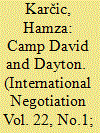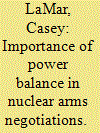| Srl | Item |
| 1 |
ID:
151228


|
|
|
|
|
| Summary/Abstract |
This research examines Zartman’s formulation of mutually hurting stalemate and mutually enticing opportunity as variables pushing and pulling parties toward agreement during the negotiation that took place between southern and northern Sudan between 2002 and 2005. This case shows that ripeness theory and formulating the push and pull factors indeed help clarify what brought the parties to negotiate and reach an agreement. However, we contend that the push and pull formulation in its current form might not fully account for the complexity of processes in ethno-political intractable conflicts, such as in Sudan, when the process is characterized by the parties’ mutual distrust and the deep involvement of third parties, driven by their own domestic and foreign policy interests.
|
|
|
|
|
|
|
|
|
|
|
|
|
|
|
|
| 2 |
ID:
151227


|
|
|
|
|
| Summary/Abstract |
U.S. mediation towards resolving the Arab-Israeli conflict in the 1970s and Balkan conflicts in the 1990s may not seem comparable at first. Differences between these conflicts in terms of history, duration and dynamics abound. The nature and level of U.S. involvement provides further contrasts. Yet, the Camp David negotiations in 1978 and the Dayton Peace Talks in 1995 offer striking parallels in terms of third-party mediator actions undertaken. This article compares the two summits by applying the analytic framework developed by Curran, Sebenius and Watkins to categorize third party mediator strategies. The analysis builds on this framework and deduces common tactics employed by third-party mediators at Camp David and Dayton.
|
|
|
|
|
|
|
|
|
|
|
|
|
|
|
|
| 3 |
ID:
151232


|
|
|
|
|
| Summary/Abstract |
This article examines the role of power interchanges in hindering collaborative efforts over shared water resources in the Eastern Nile River. We track the formative process of riparian countries’ narratives, showing how they problematize the watershed differently in accordance with the typology of power dimensions laid out under a proposed framework called Power on Water to Water Policy (PWWP). The framework presented attempts to give: (i) a power analysis of the riparian countries’ interactions, and (ii) a prescription of intervention avenues for river basin governance. The use of scientific literature and interviews triangulate data collection to ensure a more accurate analysis. Application of the PWWP framework is shown to contribute an original perspective to watershed management, enabling first, a comprehensive understanding of the Eastern Nile River situation from a power and institutional perspective and second, the identification of elements disrupting effective implementation of water resources management in the watershed.
|
|
|
|
|
|
|
|
|
|
|
|
|
|
|
|
| 4 |
ID:
151233


|
|
|
|
|
| Summary/Abstract |
Theorists debate whether symmetry or asymmetry of the power balance can help bring about bargaining success. Arbitration is difficult because the ‘Symmetry Theory’ accepts Structuralist theoretical conventions, while the ‘Asymmetry Theory’ rejects such conventions. This article employs a ‘Nuclear Weapons Addendum’ to strengthen the Asymmetry Theory by allowing it to explain bargaining results in symmetric and asymmetric cases without dismissing Structuralist assumptions. We analyze comparative case studies of the Cuban Missile Crisis and the Intermediate-Range Nuclear Forces Treaty to argue that this modified Asymmetry Theory provides a more convincing narrative that should be considered in Structuralist discussions of international negotiation.
|
|
|
|
|
|
|
|
|
|
|
|
|
|
|
|
| 5 |
ID:
151231


|
|
|
|
|
| Summary/Abstract |
Track II diplomacy, or unofficial interactions designed to produce ideas, build relationships, and change perceptions, has become a supplement – and sometimes an alternative – to traditional diplomacy. Yet practitioners and scholars still debate its effectiveness. Practitioners claim that Track II diplomacy promotes peace but insist that its contributions are intangible and therefore difficult to assess empirically. Meanwhile, scholars maintain that only rigorous empirical evaluation can demonstrate the effect of Track II diplomacy on conflict outcomes. This study seeks to break this impasse in two ways. First, it provides a comprehensive explanation of why Track II practitioners object to evaluation, drawing on personal interviews conducted in eight countries. Second, it proposes a new evaluation framework, which we call the “Process Peace” approach, which better balances practitioner and scholarly equities. Our framework should appeal to readers interested in bridging the gap between the practice and theory of Track II diplomacy.
|
|
|
|
|
|
|
|
|
|
|
|
|
|
|
|
| 6 |
ID:
151229


|
|
|
|
|
| Summary/Abstract |
Reforming the United Nations Security Council has been on the agenda of the General Assembly for over two decades. However, structural reform of the Council remains elusive. This article explains why after so many years nearly all 193 states within the UN remain actively seized on the matter of reform, despite no immediate outcome being in sight. In order to analyze Security Council reform efforts and the various obstacles along the way, this article emphasizes states’ motivations during the reform process. With the help of new institutionalist theory, an argument is formed that highlights how certain states are driven by strategic calculations and self-interest, while others are more normatively motivated. Furthermore, the article highlights that despite only lukewarm support for reform from certain states, not a single state can publicly denounce Council reform, because the reform issue itself has become an ingrained norm.
|
|
|
|
|
|
|
|
|
|
|
|
|
|
|
|